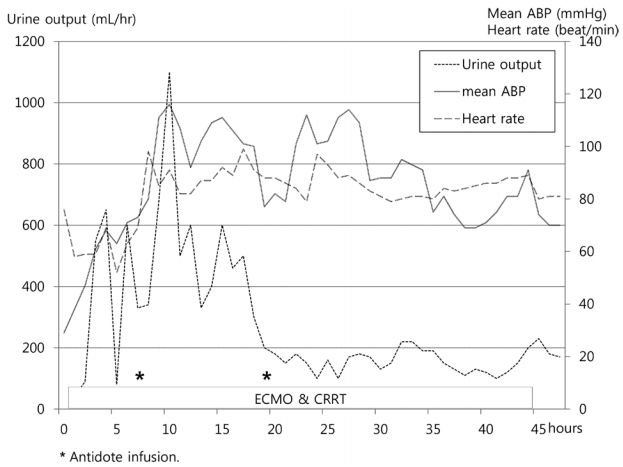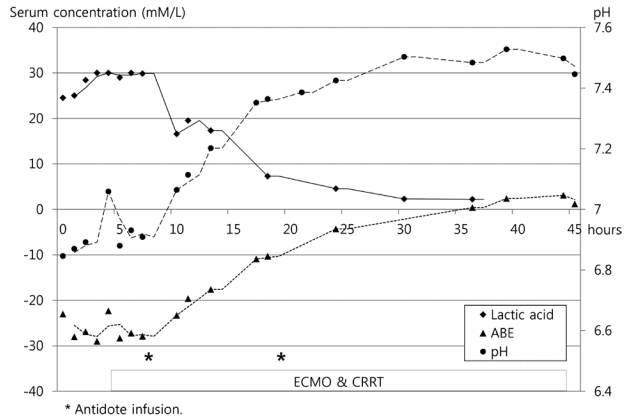This article has been
cited by other articles in ScienceCentral.
Abstract
Cyanide intoxication results in severe metabolic acidosis and catastrophic prognosis with conventional treatment. Indications of extracorporeal membrane oxygenation (ECMO) and continuous renal replacement therapy (CRRT) are expanding to poisoning cases. A 50-year-old male patient arrived in the emergency room due to mental change after ingestion of cyanide as a suicide attempt 30 minutes prior. He was comatose, and brain stem reflexes were absent. Initial laboratory analysis demonstrated severe metabolic acidosis with increased lactic acid of 25 mM/L. Shock and acidosis were not corrected despite a large amount of fluid resuscitation with high-dose norepinephrine and continuous renal replacement therapy. We decided to apply ECMO and CRRT to allow time for stabilization of hemodynamic status. After administration of antidote infusion, although the patient had the potential to progress to brain death status, vital signs were improved with correction of acidosis. We considered the evaluation for organ donation. We report a male patient who showed typical cyanide intoxication as lethal metabolic acidosis and cardiac impairment, and the patient recovered after antidote administration during vital organ support through ECMO and CRRT.
Go to :

Keywords: brain death, cyanides, extracorporeal membrane oxygenation, organ transplantation, renal replacement therapy
Cyanide intoxication occurs through various routes of industry and daily life in a number of chemical processes such as electroplating and metal refinery, cyanogenic food intake, and suicide. This extremely toxic material is presented in intoxicated patient as refractory metabolic acidosis, rhabdomyolysis, heart failure, and then it leads to death in almost 40-50% of cases.[
1] Several reports contend that recovery from cyanide induced severe intoxication, but most of them showed catastrophic prognosis with conventional treatment. Various therapeutic strategies have been implemented to manage severe cyanide intoxication. For example, continuous renal replacement therapy (CRRT) is essential for medically refractory metabolic acidosis such as cyanide intoxication. Recently, indications of extracorporeal membrane oxygenation (ECMO) are expanding for various patients, including intoxicated cases that showed transient cardiac dysfunction.[
2] In this study, we report a male patient who went down with refractory metabolic acidosis after cyanide intake and recovered by antidote during the maintenance of vital organ function by ECMO and CRRT.
Case Report
A 50-year-old male patient with a history of depression was arrived at the emergency room and was transferred to the intensive care unit because of mental alteration after the ingestion of an unknown amount of cyanide for suicide attempt that had occurred 30 minutes before that. The patient’s mental status was coma and the brain stem reflexes were all absent, including pupil, corneal, and oculocephalic reflexes. Vital signs were as follows: 35.4℃ with a respiratory rate of 15/minute, heart rate of 62 beats/minute, and blood pressure of 42/17 mmHg. The patient’s skin was pinkish and dry. Mechanical ventilator was applied after immediate intubation. Initial laboratory analysis demonstrated severe metabolic and respiratory acidosis as pH 6.846, pCO2 61.8 mmHg, pO2 40 mmHg (with FiO2 0.8), bicarbonate 10 mM/L, acid base excess of -23 mM/L, lactic acid 25 mM/L, leukocytosis (17,000 cells/μL), sodium 154 mM/L, potassium 4.4 mM/L, creatinine 1.25 mg/dL, and glucose 325 mg/dL. After increased FiO2 to 1.0, central venous oxygen saturation (95.8%) was almost same as level as that in arterial blood (97.2%). There was no acutely developed lesion on the brain computed tomography without evidence of partial or generalized seizure. Despite the administration of more than 2,000 mL of crystalloid fluid resuscitation with high dose of norepinephrine (1.0 µg/kg/min), epinephrine (1.0 µg/kg/min), dopamine (20 µg/kg/min), dobutamine (20 µg/kg/min) during the first hour, arterial blood pressure was 64/47 mmHg. Furthermore, metabolic acidosis was not improved though intravenous bicarbonate infusion and the subsequent CRRT of continuous venovenous hemodiafiltration mode (Prisma flex®, Gambro, Lund, Sweden) with blood flow 150 mL/min, pre-filter flow rate 500 mL/hr, dialysate 1,000 mL/hr, replacement 2,000 mL/hr were performed. To gain time for the stability of hemodynamic status until the recovery from organ failure, we decided to apply venoarterial ECMO. ECMO was delivered using Rotaflow pump and PLS membrane (Maquet, Rastatt, Germany). Pump flow was started at 3.3 L/min, kept between 2.5 and 3 L/min for 24 hours, and then gradually decreased to 0.84 L/min. Anti-coagulation was not started because of severe coagulopathy. Vasopressor and inotropic agent requirement decreased substantially over the time.
Sodium nitrate 300 mg IV, sodium thiosulfate 12.5 g IV infusion started after 8 hours from admission, because of the antidote was not in stock and it took time to transport it from Korean Orphan Drug center. After antidote was admitted, mean arterial blood pressure increased to 80 mmHg as cardiac output improved and metabolic lactic acidosis was gradually corrected (
Fig. 1 and
2). However, mental status and brain stem reflex were still not recovered due to severe hypoxic brain damage, even though ECMO had been successfully weaning during 2 days. 3
rd hospital day, after the announcement of potential brain death, family members of the patient decided that they wanted to donate for organ transplantation and stop additional treatment. The patient was transferred to the brain death management team for preparation for organ transplantation.
 | Fig. 1.Improvement in hemodynamic parameters of a cyanideintoxicated patient during management. After application of extracorporeal membrane oxygenation (ECMO) and continuous renal replacement therapy (CRRT), the patient’s mean arterial blood pressure (ABP) and urine output were gradually recovered. 
|
 | Fig. 2.Changes in metabolic variables of the cyanide-intoxicated patient during management. Severe lactic acidosis of the patient also improved with extracorporeal membrane oxygenation (ECMO), continuous renal replacement therapy (CRRT), and antidote administration (asterisk). ABE: acid base excess. 
|
Go to :

Discussion
Clinical manifestation of cyanide intoxication is induced by the inhibition of electron transport chain in the mitochondrial cytochrome complex. It results in blocking of oxidative phosphorylation and the initiation of anaerobic metabolism of glucose that leads to lactic acidosis. Inhalation, ingestion, and absorption from any surface of human body, including mucosa and skin, are possible.[
3] Cyanide is metabolized as detoxification products as follows: thiocyanate by rhodanese with thiosulfate as co-enzyme, 2-amino-2-thiazoline-4-carboxylic acid, and α-ketoglutarate cyanohydrin. Elimination half-life is known as 1.2-66 hours in vivo, but it can be changeable when cyanide dose exceeds patient detoxification capacity.[
4,
5]
Because of irreversible mitochondrial impairment, cyanide intoxication affects organs with high oxygen demand, such as the brain, heart, and liver. This explains progressive cardiac failure, acute mental change, and delayed neurological complications after intoxication. Clinical manifestations depend on the dose, type, and route of poisoning. Patients show severe metabolic acidosis due to lactic acidosis over 10 mM/L, followed by respiratory compensation, tachycardia as elevated catecholamine, and finally, apnea and hypotension with bradycardia. One of the characteristic features is a reduced venous-arterial PO2 gradient. Therefore, venous blood is also of a bright-red color and the skin acquires a pinkish ‘cherry’ discoloration. Test for blood cyanide concentration is a confirmatory diagnostic tool, but the results may be unreliable and have limitations of timely access before treatment. Starting immediate treatment is recommended, if cyanide intoxication is clinically suspected.
Management of cyanide intoxication is mainly conservative treatment including 100% of oxygen supply with fluid and bicarbonate for the correction of metabolic acidosis. At the same time, antidotes, such as sodium nitrite, sodium thiosulfate, and hydroxocobalamin, are administrated as soon as possible, which is important for the prognosis of severe intoxicated patients.
Despite all supportive management and antidote administration, if ingested, mortality is almost 95% because of a lethal dose for suicidal attempt.[
6] In recently severe drug poisoning cases, ECMO has been used to allow time for drug redistribution and salvage therapy in order to maintain vital organ function.[
2,
7] According to these studies, ECMO may support improving survival in critically poisoned patients presented with cardiac failure or medically refractory shock.
In the presented case, the patient showed the characteristic clinical symptoms and laboratory findings of cyanide intoxication, although cyanide dose and level was not confirmed. Dramatic clinical improvement of the patient after adding cyanide antidotes also supports cyanide poisoning in this case. Even though the patient deteriorated to brain death, organ function including kidney and liver improved with ECMO and CRRT supply. Several reports of organ transplantation from brain death patients after cyanide intoxication show a successful 1-year outcome in 75% of cases, including kidney, cornea, and other organ transplantation. [
8-
10] Another study shows more than 70% of transplant specialist would accept organ harvesting from cyanide-poisoned patients.[
11] Therefore, using ECMO as a bridge to organ transplantation in carefully selected poisoned patients is another helpful way for activation of organ donation for which there is a worldwide need.
We decided to organ donation because of recovered vital organ function after treatment and decision of the patient’s family. However, organ transplantation was canceled due to Korean Network for Organ Sharing worried about complications and rejected the organ donation process. As discussed above, several reports support transplantation of organs from cyanide intoxicated patient. We suppose that poisoned patients need to reconsider as organ donor.
Herein, we report a male patient who showed typical cyanide intoxication as lethal metabolic acidosis and cardiac impairment, and the patient recovered by antidote during the maintenance of cardiac function by ECMO. Also, we would like to suggest that ECMO may represent as a supportive therapeutic tool and a bridge to organ transplantation in patients with cyanide intoxication.
Go to :







 ePub
ePub Citation
Citation Print
Print


 XML Download
XML Download